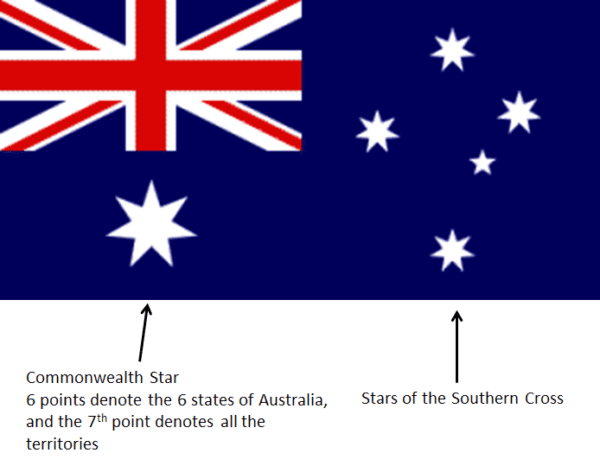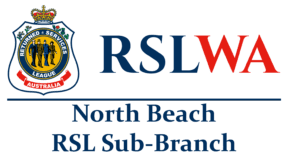The Australian National Flag is Australia’s foremost national symbol. It was first flown in 1901 and has become an expression of Australian identity and pride.

The Australian National Flag flies over the Federal and State parliaments. The flag is paraded by our defence forces and displayed around the country at sporting events and by service organisations, schools, community groups and private citizens.
The Australian National Flag has three elements on a blue background: the Union Jack, the Commonwealth Star and the Southern Cross.
- The Union Jack in the upper left corner acknowledges the history of British settlement.
- Below the Union Jack is a white Commonwealth or Federation star. It has seven points representing the unity of the six states and the territories of the Commonwealth of Australia. The star is also featured on the Commonwealth Coat of Arms.
- The Southern Cross is shown on the fly of the flag in white. This constellation of five stars can be seen only from the southern hemisphere and is a reminder of Australia’s geography.
HISTORY
The colonies of Australia federated to become a single Commonwealth in 1901. That year, Australia’s first Prime Minister, the Rt Hon Sir Edmund Barton announced an international competition to design a flag for the new nation. It attracted 32,823 entries. Five near-identical entries were awarded equal first and the designers shared the £200 prize.
The Australian National Flag was flown for the first time in September 1901 at the Exhibition Building in Melbourne, which was then the seat of the federal government.
It was announced in Commonwealth of Australia Gazette No 8 of 1903 that King Edward VII approved designs for the flag of Australia, known as the Commonwealth Blue Ensign, and for the flag of the merchant navy, known as the Commonwealth Red Ensign. The stars of the Southern Cross were simplified to four seven-pointed stars and one five pointed star. (The 1901 design depicted the stars with a differing number of points to signify their brightness). In 1908 a seventh point was added to the Commonwealth star to represent the Australian territories.
Confusion developed surrounding the use of the two Australian flags. The blue ensign was intended for official and naval purposes only and the red ensign was to be used by the merchant fleet. However, the public also began using the red ensign on land. In 1941, Prime Minister the Rt Hon Robert Menzies issued a press statement recommending the flying of the blue ensign as a national emblem. The Flags Act 1953 ended confusion about which ensign to use.
An amendment to the Flags Act 1953 was passed in 1998 to ensure that the Australian National Flag can be changed only with the agreement of the Australian people
PROTOCOLS
As the nation’s foremost symbol, the Australian National Flag should be used with respect and dignity. These protocols are to assist you when flying or using the flag.
Link Australian Flag Protocols
FLYING THE FLAG
- The flag should be raised briskly and lowered ceremoniously.
- The flag should be raised no earlier than first light and lowered no later than dusk.
- When the flag is raised or lowered, or when it is carried in a parade or review, everyone present should be silent and face the flag. People in uniform should salute.
- The flag should always be flown freely and as close as possible to the top of the flagpole with the rope tightly secured.
- Unless all flags are raised and lowered simultaneously, the Australian National Flag should be raised first and lowered last.
- When the Australian National Flag is flown with flags of other nations, all flags should be the same size and flown on flagpoles of the same height
- When flying with only one other national flag, the Australian National Flag should fly on the left of a person facing the flags.
- Two flags should not be flown from the same flagpole.
- The flag may be flown at night only when it is illuminated.
- The flag should never be flown if it is damaged, faded or dilapidated. When the material of a flag deteriorates it should be destroyed privately and in a dignified way. i.e. it may be cut into small unrecognisable pieces then disposed of with the normal rubbish collection.
- The flag should not be flown upside down, even as a signal of distress.
- The flag should not fall or lie on the ground or be used as a cover – although it can be used to cover a coffin at a funeral.
ORDER OF PRECEDENCE
The Australian National Flag takes precedence over all national flags when it is flown in Australia or Australian territory.
After the Australian National Flag, the order of precedence of flags is: national flag of other nations, state and territory flags, other Australian flags prescribed by the Flags Act 1953, ensigns and pennants.
The Australian National Flag should not normally be flown in a position inferior to any other flag or ensign and should not be smaller than any other flag or ensign.
FLYING FLAGS AT HALF-MAST
Flags are flown at half-mast as a sign of mourning.
The half-mast position will depend on the size of the flag and the length of the flagpole. The flag must be lowered to a position recognisably half-mast to avoid the appearance of a flag which has accidentally fallen away from the top of the flagpole. An acceptable position would be when the top of the flag is a third of the distance down from the top of the flagpole.
There are times when direction will be given by the Australian Government for all flags to be flown at half-mast.
Flags in any locality can be flown at half-mast on the death of a local citizen or on the day, or part of the day, of their funeral.
When lowering the flag from a half-mast position it should be briefly raised to the peak and then lowered ceremoniously.
The flag should never be flown at half-mast at night even if it is illuminated.
When flying the Australian National Flag with other flags, all flags in the set should be flown at half-mast. The Australian National Flag should be raised first and lowered last
